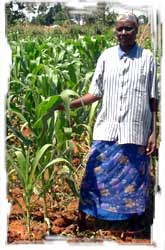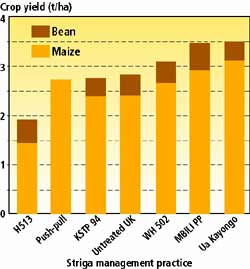CIMMYT E-News, vol 3 no. 2, February 2006
 Kenyan farmers’ verdict is out: “Ua Kayongo is the best Striga control practice and we will adopt it.”
Kenyan farmers’ verdict is out: “Ua Kayongo is the best Striga control practice and we will adopt it.”
Farmers in western Kenya overwhelmingly favor imidazolinone-resistant (IR) maize seed coated with a low dose of this herbicide to kill Striga, a highly-invasive parasitic weed that infests 200,000 hectares of Kenya’s farmland and causes crop losses worth an estimated US$ 50 million each year. This was a key finding of a recent, independent study commissioned by the African Agricultural Technology Foundation (AATF) to the Western Regional Alliance for Technology Evaluation (WeRATE; includes non-governmental organizations, farmer associations, and extension workers). Nearly 5,300 farmers in 17 districts of western Kenya evaluated eight recommended Striga management practices.
Farmers have dubbed the winning maize “Ua Kayongo”—literally, “kill Striga” in a mixed vernacular. In July 2005, the Kenya Agricultural Research Institute (KARI) and private seed suppliers started to commercialize four hybrid varieties of Ua Kayongo in Kenya.
The maize’s herbicide resistance is based on a natural mutation in the crop. Its development into Ua Kayongo was through global cooperation involving CIMMYT; KARI; the Weizmann Institute of Science, Israel; and BASF-The Chemical Company, funded by the Rockefeller Foundation and BASF. In the new practice, Ua Kayongo seed is coated with BASF’s Strigaway® herbicide, which kills Striga seedlings below ground. This prevents them from fastening to the roots of maize seedlings, from which they suck away water and nutrients.
 Farmers in the WeRATE evaluations were able to plant the new maize using their normal husbandry methods, including intercropping with legumes and root crops. “I’ve been pulling and burying Striga on my 5-acre farm for the past 17 years and the problem has only grown worse,” said Rose Katete, a farmer from Teso; “Ua Kayongo has provided the best crop of maize that I’ve ever grown!”
Farmers in the WeRATE evaluations were able to plant the new maize using their normal husbandry methods, including intercropping with legumes and root crops. “I’ve been pulling and burying Striga on my 5-acre farm for the past 17 years and the problem has only grown worse,” said Rose Katete, a farmer from Teso; “Ua Kayongo has provided the best crop of maize that I’ve ever grown!”
Katete’s observations bear out CIMMYT and partners’ findings from several years of field trials: “Under Striga-infested conditions, the new maize hybrids out-yield the checks by more than 50%, and provide near-total Striga control,” says Marianne Bänziger, Director of the CIMMYT Maize Program.
Over the next five years, the new Striga control package will be made available to farmers in Tanzania, Uganda, and Malawi, and eventually, other countries of sub-Saharan Africa with a Striga weed problem.
For more information contact Fred Kanampiu (f.kanampiu@cgiar.org)